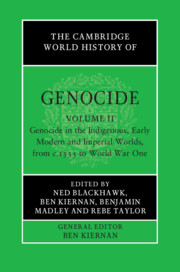Book contents
- The Cambridge World History of Genocide
- The Cambridge World History of Genocide
- The Cambridge World History of Genocide
- Copyright page
- Contents
- Figures
- Maps
- Tables
- Contributors to Volume ii
- Introduction to Volume ii
- Part I Settler Colonialism
- Part II Empire-Building and State Domination
- Part III Nineteenth-Century Frontier Genocides
- Part IV Premonitions
- 22 Genocide and the Forcible Removal of Aboriginal Children in Australia, 1800–1920
- 23 The Killing Fields of Jiangnan
- 24 The Crime of the Congo
- 25 The Ottoman Massacres of Armenians, 1894–1896 and 1909
- 26 ‘Rivers of Blood and Rivers of Money’
- 27 Representations of the Poison Gas War on the Eastern Front, 1915–1917
- Index
24 - The Crime of the Congo
A Question of Genocide in the Congo Free State, 1885–1908
from Part IV - Premonitions
Published online by Cambridge University Press: 23 June 2023
- The Cambridge World History of Genocide
- The Cambridge World History of Genocide
- The Cambridge World History of Genocide
- Copyright page
- Contents
- Figures
- Maps
- Tables
- Contributors to Volume ii
- Introduction to Volume ii
- Part I Settler Colonialism
- Part II Empire-Building and State Domination
- Part III Nineteenth-Century Frontier Genocides
- Part IV Premonitions
- 22 Genocide and the Forcible Removal of Aboriginal Children in Australia, 1800–1920
- 23 The Killing Fields of Jiangnan
- 24 The Crime of the Congo
- 25 The Ottoman Massacres of Armenians, 1894–1896 and 1909
- 26 ‘Rivers of Blood and Rivers of Money’
- 27 Representations of the Poison Gas War on the Eastern Front, 1915–1917
- Index
Summary
Ever since Adam Hochschild wrote in 1998 that the killings and excess deaths in King Leopold II’s Congo Free State (1885-1908), though of genocidal proportions, did not, “strictly speaking,” constitute genocide, the debate his words sparked has not abated. Historians and others have embraced or denounced the proposition that what occurred in the Congo Free State during the 33 years of its legal existence, 1885-1908, was, in fact, genocidal. Officially sanctioned colonial slaughter had many names: military (in the course of war), pacifying, punitive, retaliatory, and even salutary, to teach the colonized a lesson. At times, colonial governments killed subject peoples to eliminate groups that were deemed incorrigible. The question of intent has a strange role in the study of the pace, scale, and nature of the Congo killings, which were simultaneously genocidal, exterminationist, and the unfortunate result of a highly lethal form of economic exploitation. The logic of the system of rule and economic exploitation relentlessly tended toward atrocity and murder. Whether intentional or not, the slaughter did not end until the Congo Free State itself did, and its long-term effects reverberated for many years thereafter.
- Type
- Chapter
- Information
- The Cambridge World History of Genocide , pp. 585 - 608Publisher: Cambridge University PressPrint publication year: 2023

